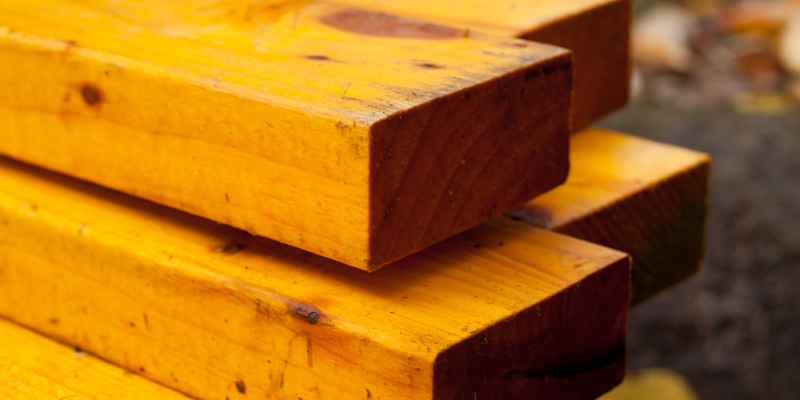Yes, you can cut treated wood safely by wearing a dust mask and applying wood preservative on the cut end. Cutting pressure treated wood can be done with proper safety precautions.
However, due to the added moisture in treated lumber, it may pose some challenges during the cutting process. It’s essential to follow specific guidelines and use protective gear to ensure a clean and safe cut. By understanding how to seal and treat the cut ends of pressure-treated wood, you can maintain the integrity of the wood and protect it from moisture and decay.
Let’s explore the necessary steps and precautions to take when cutting treated wood for various projects.
Understanding Treated Wood
When it comes to cutting treated wood, it is safe to do so as long as you take the necessary precautions. Wear a dust mask and apply a wood preservative to the cut end to prevent moisture-related issues. Avoid using treated wood in areas that come into contact with drinking water or food.
The Process Of Treating Wood
Treated wood undergoes a process that protects it from insects, water, and mold by adding moisture to the wood.
Properties Of Treated Wood
Treated wood is hard to cut due to the added moisture, which can cause the saw blade to slip and the wood to splinter.
Precautions And Safety Gear
When it comes to cutting treated wood, taking proper precautions and wearing the right safety gear is essential. Treated wood is known for its durability and resistance to insects, water, and mold. However, the process of treating the wood also adds moisture, making it harder to cut. In this section, we will discuss the recommended safety measures and the protective gear you should wear when cutting treated wood.
Protective Gear For Cutting Treated Wood
Before starting any project involving treated wood, ensure you have the right protective gear. This includes safety glasses, gloves, and a dust mask. These will protect your eyes, hands, and respiratory system from any potential hazards.
Recommended Safety Measures
- Make sure the work area is well-ventilated to minimize the inhalation of dust and fumes.
- Use a sharp saw blade specifically designed for cutting treated wood to ensure a clean and precise cut.
- Avoid cutting treated wood indoors to prevent dust and fumes from spreading throughout the space.
- Secure the wood properly before cutting to prevent any slips or accidents.
- Always follow the manufacturer’s recommendations and guidelines for cutting and handling treated wood.
By following these safety measures and wearing the appropriate protective gear, you can ensure a safer and more efficient cutting process when working with treated wood. Remember, safety should always be the top priority when undertaking any woodworking project.
Techniques For Cutting Treated Wood
When cutting treated wood, always apply wood preservative to the cut end to maintain protection against insects and moisture. Use protective gear like safety glasses and a dust mask for safety. Avoid direct contact of treated wood with food, water supplies, or beehives to prevent contamination.
Choosing The Right Saw Blade
If you’re planning to cut treated wood, it’s crucial to choose the right saw blade. Using the wrong saw blade can result in splintering, uneven cuts, or even damage to your equipment.
When selecting a saw blade, opt for one specifically designed for cutting through treated wood. Diamond-tipped blades or carbide blades with a high tooth count are highly recommended.
Best Practices For Clean Cuts
To ensure clean cuts when working with treated wood, follow these best practices:
- Wear the proper protective gear, including safety glasses, gloves, and a dust mask. Treated wood can release harmful chemicals and debris when cut.
- Prioritize safety over speed. Take your time and make gradual cuts to minimize the risk of accidents and promote accuracy.
- Begin by marking your cut line using a pencil or chalk. This will serve as a guide for the saw and help you achieve a precise cut.
- Apply light pressure to the saw and let the blade do the work. Forcing the saw can cause the blade to bind or kick back.
- Consider using a guide or fence to ensure straight cuts. This can be especially useful when cutting longer pieces of treated wood.
- After making your cuts, it’s important to treat the freshly exposed ends. Applying a wood preservative, such as copper naphthenate or oxine copper-based preservatives, can protect the wood from moisture and extend its lifespan.
By following these techniques, you can achieve clean and precise cuts in treated wood, allowing you to complete your projects successfully.
Treating Cut Ends Of Treated Wood
When working with treated wood, it’s crucial to properly handle the cut ends. After cutting, seal the ends with a wood preservative to protect them from moisture and potential decay. This will ensure the longevity and durability of your treated wood projects.
Importance Of Treating Cut Ends
Cut ends of treated wood are vulnerable to moisture and rot. Properly treating these ends is crucial to maintain the wood’s integrity and extend its lifespan.
Types Of Wood Preservatives For Cut Ends
- Copper Naphthenate: Effective preservative for outdoor applications.
- Oxine Copper: Ideal for protecting cut ends exposed to moisture.
Challenges And Solutions
Treating wood not only protects it from insects, water, and mold, but it also adds moisture to the wood, making it harder to cut. This can present challenges when working with treated wood, but fear not! There are solutions to help you tackle these challenges and ensure a smooth cutting experience.
Handling Hardness Of Treated Wood
The hardness of treated wood can make it difficult to cut smoothly. However, with the right techniques and tools, you can overcome this challenge. Consider the following solutions:
- Use a sharp saw blade: A dull blade will struggle to cut through the dense fibers of treated wood. Ensure your blade is sharp and in good condition before starting your project. Sharpen or replace the blade if necessary.
- Choose the right saw: Different saws have different cutting abilities. For treated wood, a circular saw or a miter saw with a carbide-tipped blade is recommended. These saws are designed to handle the hardness of treated wood more effectively.
- Take it slow: Cutting too quickly can cause the wood to splinter or chip. To prevent this, take your time and apply steady pressure as you cut.
- Use a cutting lubricant: Applying a cutting lubricant, such as beeswax or silicone spray, can reduce friction and make cutting easier. Apply the lubricant to the blade before cutting.
- Consider pre-drilling: If you’re cutting holes in treated wood, consider pre-drilling the holes before making the cuts. This can help prevent splintering and ensure clean cuts.
Preserving Saw Blades While Cutting Treated Wood
Cutting treated wood can be tough on saw blades, but there are steps you can take to preserve their longevity. Here are some solutions:
- Choose the right blade: Using a blade specifically designed for treated wood can help prolong its lifespan. Look for blades with carbide tips, as they are more durable and resistant to wear.
- Clean the blade: After cutting treated wood, it’s important to clean the blade to remove any resin or pitch that may have accumulated. Use a blade cleaning solution or a mixture of warm water and dish soap to wipe down the blade.
- Use a blade lubricant: Applying a blade lubricant, such as a silicone spray, can reduce heat and friction, allowing the blade to cut through the wood more smoothly. Apply the lubricant to the blade before cutting.
- Monitor blade wear: Keep an eye on the condition of your blade and replace it if it becomes dull or damaged. Using a dull blade not only hinders cutting performance but also puts unnecessary strain on the saw motor.
By following these solutions, you can overcome the challenges of cutting treated wood and ensure clean, precise cuts without compromising the lifespan of your saw blades. Remember to prioritize safety and protective gear, such as safety glasses and a dust mask, throughout the cutting process.
Best Practices

Preserving The Integrity Of Treated Wood
When cutting treated wood, it is essential to maintain its integrity to ensure longevity and durability. Here are some key tips to follow:
- Use a high-quality saw blade designed for treated wood to achieve clean cuts.
- Protect the exposed ends by applying a wood preservative immediately after cutting to prevent moisture penetration.
- Seal the cut ends using an appropriate preservative to maintain the wood’s protection against decay and insects.
Post-cutting Treatment And Maintenance
After cutting treated wood, it is crucial to provide post-cutting treatment and ongoing maintenance to keep the wood in optimal condition:
- Apply a water-resistant sealant to the cut ends to prevent water absorption and decay.
- Regularly inspect the treated wood for any signs of damage or decay, and address them promptly.
- Keep the treated wood clean and free from debris to prevent moisture buildup and mold growth.
Frequently Asked Questions Of Can You Cut Treated Wood
Is It Safe To Cut Pressure Treated Wood?
Yes, it is safe to cut pressure treated wood. It’s important to wear a dust mask and treat the cut end with a wood preservative.
Why Is Pressure Treated Wood So Hard To Cut?
Pressure treated wood is hard to cut due to excess moisture from protective treatment, causing saw blades to slip and splinter.
What Should Never Be Done With Pressure Treated Wood?
When working with pressure treated wood, there are certain things you should never do: 1. Do not use treated wood for structures that will come into direct or indirect contact with drinking water or food. 2. Avoid using treated wood near beehives or areas where animals might access it.
3. Do not cut pressure treated wood without wearing protective gear like safety glasses, gloves, and a dust mask. 4. Always coat cut ends or any exposed areas with an appropriate preservative to protect the wood. 5. Do not expose the untreated innards of the lumber by cutting it without taking necessary precautions.
Cutting pressure treated wood can damage your saw blade, so be cautious.
What Is Recommended When Cutting Pressure Treated Lumber?
When cutting pressure treated lumber, it is recommended to wear protective gear such as safety glasses, gloves, and a dust mask. Additionally, it is important to use a wood preservative on the cut end of the lumber. This helps protect against moisture and extends the lifespan of the wood.
Conclusion
In a nutshell, cutting pressure treated wood is safe if done properly with necessary precautions. Remember to wear protective gear and apply wood preservative on cut ends to maintain its durability. Taking these steps will ensure your project’s success and longevity.
Happy woodworking!


